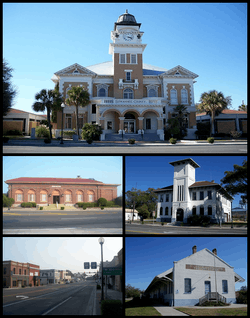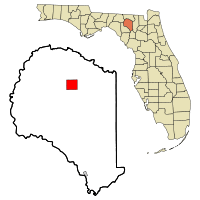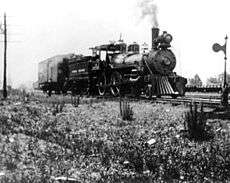Live Oak, Florida
| Live Oak, Florida | |
|---|---|
| City | |
 Suwannee County Courthouse, Old Post Office, Old Live Oak City Hall, Downtown Live Oak, ACL Freight Station | |
| Nickname(s): The city of nature | |
| Motto(s): "A Caring Community " | |
 Location in Suwannee County and the state of Florida | |
| Coordinates: 30°17′40″N 82°59′9″W / 30.29444°N 82.98583°WCoordinates: 30°17′40″N 82°59′9″W / 30.29444°N 82.98583°W | |
| Country |
|
| State |
|
| County | Suwannee |
| Area[1] | |
| • Total | 7.57 sq mi (19.61 km2) |
| • Land | 7.57 sq mi (19.61 km2) |
| • Water | 0.00 sq mi (0.01 km2) |
| Elevation | 105 ft (32 m) |
| Population (2010) | |
| • Total | 6,850 |
| • Estimate (2016)[2] | 6,965 |
| • Density | 919.96/sq mi (355.18/km2) |
| Time zone | UTC-5 (Eastern (EST)) |
| • Summer (DST) | UTC-4 (EDT) |
| ZIP codes | 32060, 32064 |
| Area code(s) | 386 |
| FIPS code | 12-40875[3] |
| GNIS feature ID | 0285862[4] |
| Website | www.cityofliveoak.org |
Live Oak is a city in Suwannee County, Florida, United States. The city is the county seat of Suwannee County[5] and is located east of Tallahassee. As of 2010, the population recorded by the U.S. Census Bureau was 6,850.
U.S. Highway 90, U.S. Highway 129 and Interstate 10 are major highways running through Live Oak.
It is served by the Suwannee County Airport as well as many private airparks scattered throughout the county.
One other Florida county also has a community named Live Oak, which is located in Washington County.
History
The founding of Live Oak dates back to shortly before the Civil War. Established in 1858, Live Oak was located at a junction between two strategically important railways: one operating between Jacksonville and Tallahassee, and another running south from Dupont, Georgia. A large live oak tree located off the railways was a gathering and resting spot for many of the workers on the line, and gave the new cityscape its name. The tree was formerly located where the now-present Pepe's Mexican Grocery on U.S. 90 is located.[6]

In 1879, the state legislature founded a normal school for blacks for the training of teachers; it developed as Florida Memorial University, now based in Miami.
The city and surrounding area was the setting for the lynching of Willie James Howard. Howard, a 15-year-old African-American man living in Live Oak, was lynched for having written a "fresh" letter to a white girl (Cynthia Goff, his co-worker in a dime store), on January 2, 1944. The girl's father, A.P. "Phil" Goff, a former state legislator, along with S.B. McCullers and Reg H. Scott, allegedly went to Willie's house and forcibly took the youth from his mother. They picked up Willie's father, James Howard, at the Bond-Howell Lumber Company where he worked, then drove to the Suwannee River east of Suwannee Springs, where they bound Willie by the hands and feet, and forced the youth to choose between getting shot and jumping into the Suwannee River. After his father said he could do nothing to save him, Willie jumped into the river and drowned. Goff, McCullers and Scott signed an affidavit which stated that they had only wanted James Howard to whip his son and, rather than be whipped by his father, Willie had committed suicide by jumping into the river. James Howard also signed the affidavit, but after selling his home and moving to Orlando, he recanted. Harry T. Moore, of the NAACP, interviewed the parents. After a county grand jury failed to indict, Moore was able to get a federal investigation started, but no convictions followed. Goff, McCullers and Scott died without having to face murder charges.
In 1952, the city attracted national attention with the trial and conviction of Ruby McCollum, a wealthy, married black woman, charged with the shooting and murder of Dr. C. Leroy Adams, a prominent married white physician and state senator. Her husband Sam McCollum had made a fortune in gambling, and there were rumors Dr. Adams was in business with him. Ruby McCollum testified that Adams had repeatedly forced her to have sex and to bear his child. The case has been described as demonstrating white men's assumption of "paramour rights" in the segregated society. Her trial was covered by journalist and novelist Zora Neale Hurston for the Pittsburgh Courier, among others. McCollum's conviction and death sentence were overturned on appeal to the state supreme court in 1954. She was judged "mentally incompetent to proceed" and committed to the state mental hospital. Her case has been the subject of books by journalist William Bradford Huie, who covered the appeal and second trial, C. Arthur Ellis, and Tammy Evans. It has also been the subject of documentary films.
Geographically, Suwannee County is situated on a limestone bed riddled with underground freshwater streams, which surface in dozens of beautiful springs. This phenomenon of "Karst topography" gives the area a local supply of renewable fresh water and abundant sources of fishing. The county is known as a world-class cave diving site for SCUBA enthusiasts, and underwater cave explorer Sheck Exley chose to live here in order to have close access to many of the springs.
The Twin Rivers State Forest is a 14,882-acre (60 km2) Florida State forest located in North Central Florida, near Live Oak.[7]
Demographics
| Historical population | |||
|---|---|---|---|
| Census | Pop. | %± | |
| 1880 | 458 | — | |
| 1890 | 687 | 50.0% | |
| 1900 | 1,659 | 141.5% | |
| 1910 | 3,450 | 108.0% | |
| 1920 | 3,103 | −10.1% | |
| 1930 | 2,734 | −11.9% | |
| 1940 | 3,427 | 25.3% | |
| 1950 | 4,064 | 18.6% | |
| 1960 | 6,544 | 61.0% | |
| 1970 | 6,830 | 4.4% | |
| 1980 | 6,732 | −1.4% | |
| 1990 | 6,332 | −5.9% | |
| 2000 | 6,480 | 2.3% | |
| 2010 | 6,850 | 5.7% | |
| Est. 2016 | 6,965 | [2] | 1.7% |
| U.S. Decennial Census[8] | |||
As of the census[3] of 2011, there were 6,918 people, 2,361 households, and 1,562 families residing in the city. The population density was 931.7 per square mile (359.5/km²). There were 2,951 housing units at an average density of 904.6 per square mile (152.3/km²). The racial makeup of the city was 54.4% White, 35.0% African American, Hispanic or Latino of any race were 16.2% of the population. 0.25% Native American, 1.0% Asian, 0.01% Pacific Islander, 2.4% from other races, and 2.4% from two or more races.
There were 2,623 households out of which 30.5% had children under the age of 18 living with them, 39.5% were married couples living together, 22.0% had a female householder with no husband present, and 33.8% were non-families. 28.4% of all households were made up of individuals and 13.5% had someone living alone who was 65 years of age or older. The average household size was 2.60 and the average family size was 3.13.
In the city, the population was spread out with 26.6% under the age of 18, 11.0% from 18 to 24, 24.1% from 25 to 44, 20.1% from 45 to 64, and 18.1% who were 65 years of age or older. The median age was 36 years. For every 100 females, there were 93.3 males. For every 100 females age 18 and over, there were 88.6 males.
The median income for a household in the city was $24,380, and the median income for a family was $29,099. Males had a median income of $22,403 versus $20,154 for females. The per capita income for the city was $12,374. About 19.6% of families and 23.9% of the population were below the poverty line, including 27.9% of those under age 18 and 20.9% of those age 65 or over.
Geography
Climate
Live Oak receives rain, on average, 84 days per year. This makes it the city that receives the fewest days of rain per year over 0.1 inches in Florida.
References
- ↑ "2016 U.S. Gazetteer Files". United States Census Bureau. Retrieved Jul 7, 2017.
- 1 2 "Population and Housing Unit Estimates". Retrieved June 9, 2017.
- 1 2 "American FactFinder". United States Census Bureau. Retrieved 2008-01-31.
- ↑ "US Board on Geographic Names". United States Geological Survey. 2007-10-25. Retrieved 2008-01-31.
- ↑ "Find a County". National Association of Counties. Retrieved 2011-06-07.
- ↑ "Live Oak, Florida", See North Florida website
- ↑ "Twin Rivers State Forest". Florida Forest Service. Retrieved May 28, 2012.
- ↑ "Census of Population and Housing". Census.gov. Retrieved June 4, 2015.
External links
| Wikimedia Commons has media related to Live Oak, Florida. |
| Wikisource has the text of the 1911 Encyclopædia Britannica article Live Oak. |
Suwannee Valley Times is a free newspaper http://www.suwanneevalleytimes.com/
- Live Oak Daily Democrat Historical newspaper for Live Oak, Florida fully and openly available in the Florida Digital Newspaper Library
- City of Live Oak City website
- Suwannee Democrat Current newspaper of record for Live Oak
